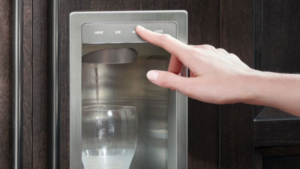
For many homeowners, the major appliances — refrigerator, washing machine/dryer, dishwasher and stove — account for the second largest percentage of their monthly utility bills. (Heating and air conditioning units are often the costliest). Generally speaking, if these appliances are more than a decade old, they will be less energy efficient which means more money out of your pocket and into that of the utility companies.
Today, thankfully, major appliances must meet minimum federal energy efficiency standards. These standards have been upgraded over the years so any new appliance today will use less energy than an old model. A brand-new energy efficient refrigerator, for instance, will use less than half the energy than that of a similar model from just 10 years ago. Granted, they come with a bit of a higher price tag, but with energy cost savings over the years should make up for the initial output of funds.
When Buying a New Major Appliance Look For:
1. The Energy Star Label
Energy Star® models are the most energy efficient product category. These appliances feature an Energy Star® label, which identifies them as appliances that exceed the energy efficiency minimums set by the federal government.
Texas has rebates for appliances with the Energy Star® label.
2. EnergyGuide Label
In addition to the Energy Star® label on appliances, the Department of the Environment (DOE) also requires most appliances to have an EnergyGuide label. These yellow labels provide the energy efficiency statistics for that particular appliance, including basics like size and model, plus estimated yearly operating costs and energy consumption.
While they only display average usage costs, EnergyGuide labels offer insight into how much money you might spend or save on energy over an appliance’s lifetime.
3. Energy Saving Settings
Refrigerators:
- Some newer refrigerators have a power saver mode or vacation mode. If there’s not very much in your fridge to keep cool, then engaging the power saver mode will reduce energy consumption.
Dishwashers:
- Light wash settings – uses less water, shorter cycle
- Energy-saving mode (or eco setting) – conserves water (and water heating energy) used by other cycles, without sacrificing the ability for a heavy-duty cleaning when needed.
- Air dry cycle – uses unheated air to dry your dishes. You can save about 15-50 percent of your dishwasher’s operational cost with this feature.
Washing Machines:
For clothes washers, the amount of water, temperature of the water and length of cycle can determine your expenses. Look for load-sensing technology to add the exact amount of water your laundry needs.
For large families look for high efficiency (HE) washers. HE washers feature technology that helps reduce the amount of water and energy to do a load.
- Uses up to 50-80 percent less water.
- They wash up to 40 percent more clothes per load. One reason they can hold more clothes is the absence of an agitator in the drum, which also means the wash process is gentler on your clothes.
Dryers:
- Temperature sensor: Uses the temperature of the dryer exhaust air to estimate when clothes are dry and automatically shuts off the dryer.
- Moisture sensor: Shuts the dryer off when the humidity of exhaust air indicates that the clothes are dry.
You might also consider a ventless heat pump dryer. They are becoming popular in Europe and are proving to be twice as efficient as standard dryers. Several U.S. manufacturers have been selling these since 2014.
A couple of drawbacks of heat pump dryers are that they are more expensive than most vented dryers (although prices are starting to drop slightly) and not many brands offer large sized models.
What About Smart Appliances?
Some manufacturers are now offering “smart” appliances. These can be connected to home energy management systems to help you shift your electricity use to off-peak hours. Refrigerators, dishwashers, and other appliances may be available as smart appliances.
Smart appliances don’t just turn off during times of peak electricity demand — they use subtle ways to shift energy use that you might not even notice. For instance, your refrigerator might delay its defrost cycle until the middle of the night. If your utility charges lower rates for electricity at night, also called time-based rates, you could save on your utility bill. Ask your utility provider about this.
Size Matters
Make sure the product you’re buying is the size you want but isn’t significantly oversized for your needs. For instance, oversized refrigerators waste energy and money and in some cases don’t perform as well.
Sometimes, Design Matters
- Refrigerator units with the freezer on the top or bottom are generally more efficient than units with side-by-side doors.
- Ice makers and water dispensers add convenience but also add to the energy consumption of the refrigerator.
If You’re on a Budget, Prioritize
Certain appliances consume more energy than others, so it makes sense to replace the least efficient (usually the oldest) and most energy-hungry appliances.
For instance, refrigerators are one of the most energy-intensive home appliances. Energy Star models can save 15 percent on utility costs compared to standard models, and 40 percent compared to the conventional fridges sold in 2001.
In areas with high water costs, a new Energy Star certified washing machine can use up to 45 percent less water than standard models, making it a practical investment.
Whatever the age of your appliances, you can count on C&W Appliance Service for all your repair and maintenance needs. Call us at (855) 358-1496 or contact us online for prompt service.



